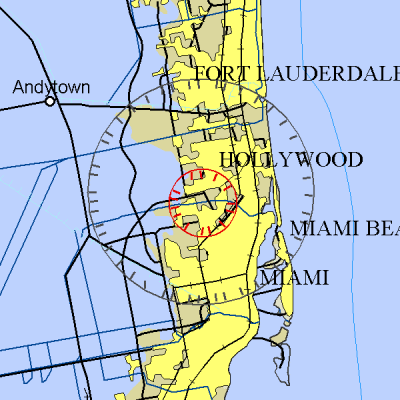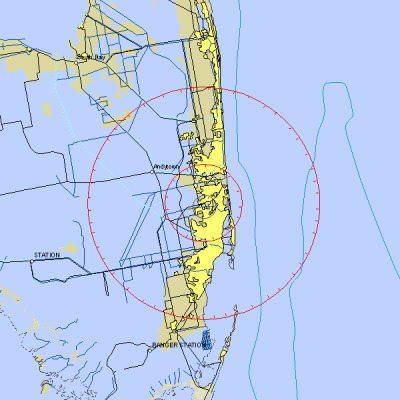Both Games Taking Place At Dolphin Stadium In Miami
 The FAA has posted TFR's for the next two weekends over
Dolphin Stadium in Miami for the Pro Bowl on January 31st, and the
Super Bowl on February 7th.
The FAA has posted TFR's for the next two weekends over
Dolphin Stadium in Miami for the Pro Bowl on January 31st, and the
Super Bowl on February 7th.
The TFR for the Pro Bowl will center on the Fort Lauderdale
VOR/DME (FLL) 214 degree radial at 8.4 nautical miles. (Latitude:
25º57'28"N, Longitude: 80º14'19"W) and extend for three
nautical miles in all directions from the surface to 3,000ft
AGL. The Pro Bowl TFR will be in effect from Sunday, January
31st at 1830 EST until 2359 EST.
Except as specified below and/or unless authorized by ATC in
consultation with the Air Traffic Security Coordinator via the
Domestic Events Network (DEN), aircraft must be on a discreet code
assigned by and ATC facility. Aircraft must be squawking the
discrete code prior to departure and at all times while in the TFR,
and must remain in two-way radio communications with ATC. Aircraft
may not loiter in the area covered by the TFR. The exceptions are
military, law enforcement, fire fighting, and medevac aircraft, as
well as aircraft operations necessitated for safety or emergency
reasons.

Pro Bowl TFR
The TFR for the Super Bowl is more extensive. An inner ring
centers on the Fort Lauderdale VOR/DME (FLL) 218 degree radial at
7.6 nautical miles. (Latitude: 25º58'28"N, Longitude:
80º14'19"W). It extends 10 nautical miles in all directions
and goes from the surface up to FL180. An outer ring extends to 30
nautical miles in all directions from the stadium. Both areas are
in effect from 1600 to 2359 on Sunday, February 7th.
For the inner core, or Area B, all aircraft operations are
prohibited except for approved law enforcement and approved
military aircraft directly supporting the Super Bowl, approved air
ambulance flights, and regularly scheduled commercial passenger and
all-cargo carriers operating under one of the following
TSA-approved standard security programs/procedures: Aircraft
Operator Standard Security Program (AOSSP), Full All-Cargo Aircraft
Operator Standard Security Program (FACAOSSP), Model Security
Program (MSP), Twelve Five Standard Security Program (TFSSP) All
Cargo, or All-Cargo International Security Procedure (ACISP) and
are arriving into and/or departing from 14 CFR Part 139 Airports.
All Emergency/life saving flights (medical/law
enforcement/firefighting) operations must coordinate with the
FAA.
In the outer ring, or Area A, all aircraft operating within the
outer ring(s) listed above are limited to aircraft arriving or
departing local airfields, and workload permitting, ATC may
authorize IFR transit operations with prior coordination with the
DEN. Aircraft may not loiter. All aircraft must be on an active IFR
or VFR flight plan with a discrete code assigned by an Air Traffic
Control (ATC) facility. Aircraft must be squawking the discrete
code prior to departure and at all times while in the TFR and must
remain in two-way radio communications with ATC.

Super Bowl TFR
The following operations are not authorized within this TFR:
Flight training, practice instrument approaches, aerobatic flight,
glider operations, parachute operations, ultralight, hang gliding,
balloon operations, agriculture/crop dusting, animal population
control flight operations, banner towing operations, sightseeing
operations, model aircraft operations, model rocketry,
seaplane/amphibious water operations, and unmanned aerial systems
(UAS).
Any person operating an aircraft within this TFR who becomes
aware of an inability to comply with the requirement to
continuously squawk the ATC assigned transponder code must
immediately request control instructions and comply with all
instructions from ATC. If unable to contact ATC, pilots must exit
the TFR by the most direct lateral route.
The FAA advises that noncompliance with this TFR may result in
the use of force. All aircraft operators are advised to check
NOTAMs frequently for possible changes to this TFR prior to
operations within this region.
 Bolen Gives Congress a Rare Thumbs-Up
Bolen Gives Congress a Rare Thumbs-Up The SportPlane Resource Guide RETURNS!!!!
The SportPlane Resource Guide RETURNS!!!! Buying Sprees Continue: Textron eAviation Takes On Amazilia Aerospace
Buying Sprees Continue: Textron eAviation Takes On Amazilia Aerospace Hawker 4000 Bizjets Gain Nav System, Data Link STC
Hawker 4000 Bizjets Gain Nav System, Data Link STC Echodyne Gets BVLOS Waiver for AiRanger Aircraft
Echodyne Gets BVLOS Waiver for AiRanger Aircraft





